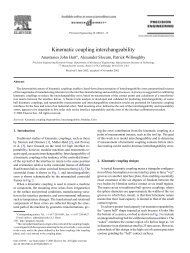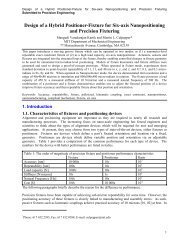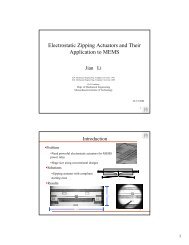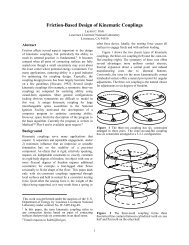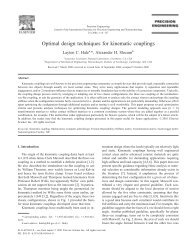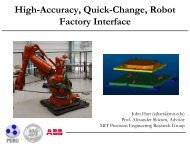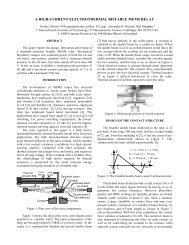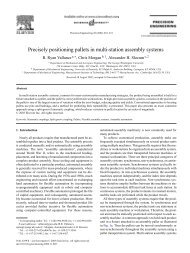Design and Analysis of Kinematic Couplings for Modular Machine ...
Design and Analysis of Kinematic Couplings for Modular Machine ...
Design and Analysis of Kinematic Couplings for Modular Machine ...
Create successful ePaper yourself
Turn your PDF publications into a flip-book with our unique Google optimized e-Paper software.
Compared to a design <strong>for</strong> seating with little or no dynamic disturbance, design <strong>of</strong> kinematic interfaces<strong>for</strong> high disturbance loads, with high-cycle applications, requires consideration <strong>of</strong> interface strength <strong>and</strong>stability in three areas:1. Static per<strong>for</strong>mance: resistance <strong>of</strong> the coupling to compressive yield in the Hertzian contactzones.2. Dynamic per<strong>for</strong>mance: stiffness <strong>of</strong> the coupling interface <strong>and</strong> deflections at the point <strong>of</strong> errormeasurement upon application <strong>of</strong> large dynamic <strong>for</strong>ces <strong>and</strong> torques3. Long-term durability: integrity <strong>of</strong> the contact surfaces over several million load cycles.When disturbance <strong>for</strong>ces are applied, the interface design must remain stable at all points within thedisturbance space. Considering the disturbance to be a set <strong>of</strong> three orthogonal <strong>for</strong>ces <strong>and</strong> three orthogonalmoments applied at a central point, stability throughout the disturbance space is guaranteed if stabilityexists at all limits <strong>of</strong> the disturbance space. Hence, when the six-tuple is defined in a dynamic applicationas a set <strong>of</strong> six upper-bound <strong>and</strong> lower-bound cycle limits, the linear nature <strong>of</strong> the <strong>for</strong>ce-equilibrium systemguarantees that the extreme point will be at one <strong>of</strong> the sixty-four combinations <strong>of</strong> the individual <strong>for</strong>ce <strong>and</strong>moment limits.Considering these principles, in the case <strong>of</strong> a nominally deterministic interface such as one <strong>of</strong> traditionalor canoe ball couplings, an iterative design procedure is defined:1. Given the disturbance <strong>for</strong>ces (disturbance space) <strong>and</strong> interface geometry (coupling positions <strong>and</strong>groove angles), determine the preload necessary to maintain stability <strong>of</strong> the interface.2. Given a nominal material choice, determine the contact surface radius (or radii if desired to be different)necessary to support the superposition <strong>of</strong> this preload onto the disturbance <strong>for</strong>ce space, withoutcausing simple compressive failure in the contact zone.3. Verify the high-cycle per<strong>for</strong>mance <strong>of</strong> the interface based upon surface <strong>and</strong> mechanical integrityfatigue-life relations, choosing a different material if necessary. Recalculate the necessary surfaceradius if desired <strong>and</strong> re-check <strong>for</strong> durability.4. Choose an appropriate fastener to support the tensile preload <strong>and</strong> tensile disturbance loads, consideringstatic <strong>and</strong> high-cycle dynamic per<strong>for</strong>mance. If the preload is applied through the center <strong>of</strong>the coupling, appropriately package the fastener through a clearance hole, increasing the size <strong>of</strong> thecontact elements if necessary.With more design freedom, it is straight<strong>for</strong>ward to extend this process into an iterative optimization; e.g.determining the coupling positions <strong>and</strong> angles that maximize interface stability <strong>and</strong>/or minimize the contactstress ratios given the magnitude <strong>and</strong> breadth <strong>of</strong> the disturbance load space.25




